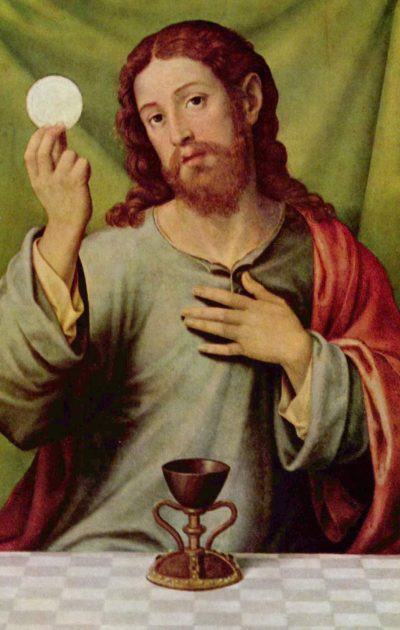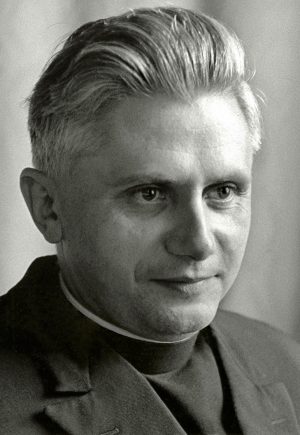Your distress shall be turned into joy
 The Discourse in the Cenacle
The Discourse in the Cenacle
So profound, so unsearchable, so full of mystery is the discourse of Our Lord in the Cenacle on the night before He suffered, that the Church makes us listen to it, repeat it, and pray it all through Paschaltide. These are the same Chapters 13—17 of Saint John’s Gospel that we, Benedictine Monks of Perpetual Adoration, read and meditate every Thursday. In this discourse, as transmitted by Saint John, the institution of the Most Holy Eucharist and of the Priesthood lie hidden, like a treasure buried in the field, or like a precious pearl waiting to be discovered. In this same discourse, Our Lord reveals to us much of what must happen to His Bride and Body, the Church, in her pilgrimage through history.
Like the Pangs of Childbirth
In today’s Gospel, Our Lord speaks of a great sorrow, of a distress like that of a woman in the pangs of childbirth. The words of the Gospel transcend a single historical application. They are not merely punctual, that is, having to do with a single event that took place once long ago and in a distant place. The words of the Gospel are actual. The words of the Gospel, while springing from a precise moment in history, also interpret present events, and are the key to facing the future with hope. This is why the Church does more than merely read the Holy Gospel at Holy Mass. She announces it in the night at Matins and, then, refracts its brightness into an array of antiphons sung at daybreak’s Benedictus at daybreak, at sunset’s Magnificat, and often at the Communion of the Mass as well.
Believe me when I tell you this, you will weep and lament while the world rejoices; you will be distressed, but your distress shall be turned into joy. A woman in childbirth feels distress, because now her time has come; but when she has borne her child, she does not remember the distress any longer, so glad is she that a man has been born into the world. (John 16:20–21)
Division
What is this distress of the Church? Why does the world rejoice while the Church weeps and laments? Why this poignant promise of a distress turned into joy? The distress of the Church comes from the ever–widening division that separates her from the world into which she is sent. On one side of this immense divide stands Our Lord Jesus Christ and those who, having received His Word, belong to Him. On the other side stands the world that, having rejected the word of Jesus, foments opposition to Him, seeking to silence His truth, to distort His goodness, and to disfigure His beauty.
The division passes through the Church herself. There are those, visibly in the Church, who have sold themselves to the world. And there are those in the world who, though “living in darkness and in the shadow of death” (Luke 1:79), wait to receive the message of Jesus and yearn to be united to His Body, the Church. For this reason does the Lord say, through the mouth of His prophet, “The islands wait for me”.
Liturgical and Doctrinal Confusion
There is an insidious movement in the world and, alas, even in the Church, that seeks, by every means — and principally by the media and the toxic sound–bites of social communications — to obfuscate the word of Jesus and to confuse the mission of His Church to the nations. The division in the Church cuts even through the sacred liturgy. It cuts through all that pertains to the Holy Sacrifice of the Mass, and to the Body of Christ. By this I mean, His Eucharistic Body, that is the Sacred Host, and His Mystical Body, that is the Church made of up His members conjoined to Him who is the Head.
The vultures are gathering, hovering over the dismembered Body of Christ, and waiting to devour it. We read in Genesis that, “the whole day long Abram stood there, driving away the carrion-birds as they swooped down on the carcasses” (Genesis 15:11) that he had laid out for a sacrifice. Abraham is our father in faith; it is, then, by faith that we shall drive away the vultures that circle above the dismembered Church, waiting to devour her flesh.
The Passion of the Church
Only those who remain attached to the Divine Head and to the Heart that beats in the Sacred Host will survive the attacks of the vultures. The Head will be covered with shame — for the Passion of Christ must continue until the close of this age — and the Heart will be pierced through again. “Jesus”, says Blaise Pascal, “will be in agony even to the end of the world. We must not sleep during that time”. The agony of Jesus perdures in the mystery of a Church despised, a Church brought low, a Church disfigured beyond recognition. Who will weep for the Church? Who will defend the honour of the Bride of Christ? Who will speak in her defence and plead for her before the throne of God and of the Lamb?
The Hour of Darkness
It is not impossible that an hour of darkness should once again descend upon the Church, just as darkness descended upon her in the hour of Martin Luther’s revolt five hundred years ago. It is not impossible that the Church should once again be betrayed into the hands of her enemies by her own sons, and even by the shepherds set over the flock of Christ. One cannot forget that, again, five hundred years ago, all the bishops of England, save one, the martyr Saint John Fisher, betrayed the Church into schism and heresy.

Holiness and Hope
These are sobering considerations, but they should not push us into despondency. Wheresoever there is holiness of life, there too there will be hope. In every age and hour of the Church’s life, the Holy Ghost raises up men and women (and even small children) who, like so many flames flickering in dark places, keep watch before the Eucharistic Face of Jesus lest the spark of love and of knowledge be altogether snuffed out. In every age and hour of the Church’s life there are souls who discover “the secret of Mary” and, who look to her as to a guiding star set in the darkness of the firmament. Thus will the Church emerge bright and pure from the tempest that appears, at certain hours, to threaten her very survival. In 1969, a certain Father Joseph Ratzinger wrote words that today, forty–seven years later, are nothing less than prophetic. We do well to take them to heart.
The future of the Church can and will issue from those whose roots are deep and who live from the pure fullness of their faith. It will not issue from those who accommodate themselves merely to the passing moment or from those who merely criticize others and assume that they themselves are infallible measuring rods; nor will it issue from those who take the easier road, who sidestep the passion of faith, declaring false and obsolete, tyrannous and legalistic, all that makes demands upon men, that hurts them and compels them to sacrifice themselves. To put this more positively: The future of the Church, once again as always, will be reshaped by saints, by men, that is, whose minds probe deeper than the slogans of the day, who see more than others see, because their lives embrace a wider reality.
